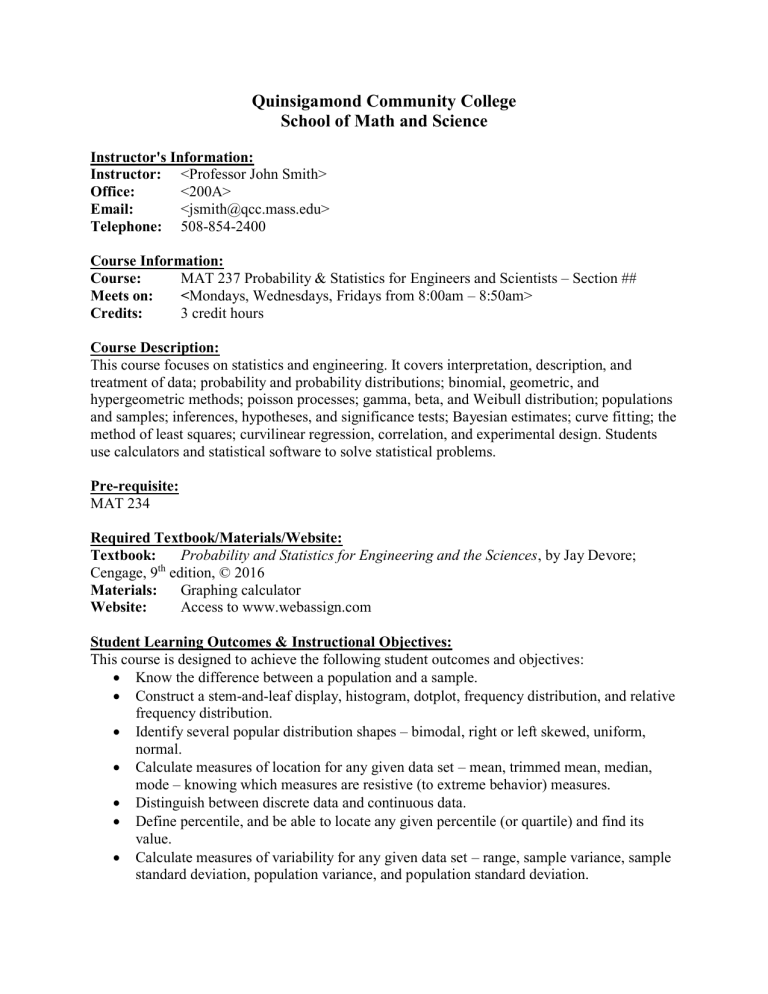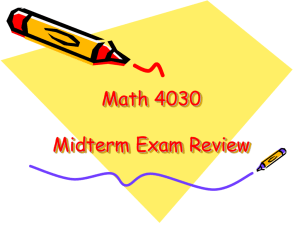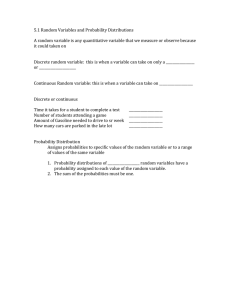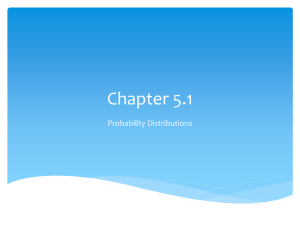
Quinsigamond Community College School of Math and Science Instructor's Information: Instructor: <Professor John Smith> Office: <200A> Email: <jsmith@qcc.mass.edu> Telephone: 508-854-2400 Course Information: Course: MAT 237 Probability & Statistics for Engineers and Scientists – Section ## Meets on: <Mondays, Wednesdays, Fridays from 8:00am – 8:50am> Credits: 3 credit hours Course Description: This course focuses on statistics and engineering. It covers interpretation, description, and treatment of data; probability and probability distributions; binomial, geometric, and hypergeometric methods; poisson processes; gamma, beta, and Weibull distribution; populations and samples; inferences, hypotheses, and significance tests; Bayesian estimates; curve fitting; the method of least squares; curvilinear regression, correlation, and experimental design. Students use calculators and statistical software to solve statistical problems. Pre-requisite: MAT 234 Required Textbook/Materials/Website: Textbook: Probability and Statistics for Engineering and the Sciences, by Jay Devore; th Cengage, 9 edition, © 2016 Materials: Graphing calculator Website: Access to www.webassign.com Student Learning Outcomes & Instructional Objectives: This course is designed to achieve the following student outcomes and objectives: • Know the difference between a population and a sample. • Construct a stem-and-leaf display, histogram, dotplot, frequency distribution, and relative frequency distribution. • Identify several popular distribution shapes – bimodal, right or left skewed, uniform, normal. • Calculate measures of location for any given data set – mean, trimmed mean, median, mode – knowing which measures are resistive (to extreme behavior) measures. • Distinguish between discrete data and continuous data. • Define percentile, and be able to locate any given percentile (or quartile) and find its value. • Calculate measures of variability for any given data set – range, sample variance, sample standard deviation, population variance, and population standard deviation. • • • • • • • • • • • • • • • • • • • • • • • • • • • • Become familiar with probability terms such as Sample Space, elements, events, complement, union, intersection, null set. Know the difference between mutually exclusive events and independent events. Use Venn diagrams to solve common set theory problems. Use the General Addition rule to calculate simple probabilities. Use the General Multiplication rule to calculate simple probabilities. Correctly apply the counting rules of Permutation and Combination to various counting and probability situations. Know the formula for and solve conditional probability scenarios. Apply Bayes’ Theorem when necessary or appropriate for conditional probabilities. Create a proper discrete probability distribution. Identify a Bernoulli distribution, a binomial probability distribution, a hypergeometric distribution, a negative binomial probability distribution, and a Poisson probability distribution. Be able to calculate the probabilities, using the appropriate formulas, for the previously mentioned distributions. Calculate the Expected value and Variance of any discrete probability distribution. Apply the knowledge for discrete random variable distributions to continuous random variable distributions. Given a PDF (probability distribution function), use calculus to find its CDF (cumulative distribution function), as well as its Expected value. Given a CDF, find its PDF, using calculus. Recognize the pdf for a Normal distribution. Understand what a standard normal distribution is, and find any probability given its zvalue. Find the z-value given a probability. Standardize any given (non-standard) random variable, given its mean and standard deviation. Know the Empirical Rule (68-95-99.7 Rule). Approximate a binomial distribution using a normal distribution, when appropriate, using continuity correction techniques. Recognize and calculate the probabilities of skewed distributions such as Exponential, Gamma, and Chi-Squared; or other distributions such as Weibull, Lognormal, and Beta. Apply the principles learned for a single-variable distribution to jointly distributed random variables, finding the appropriate probabilities for a given joint PDF. Know what is meant by a distribution of the sample mean. Calculate the standard error of the mean. Be able to know when and how to appropriately apply the Central Limit Theorem to find the probability of a sample mean. Find and interpret the confidence interval of a population mean for various confidence levels, including, but not limited to, 90%, 95%, or 99%. Know when and how to use a Student t-distribution instead of a normal (z) distribution. Calculate the necessary sample size of any given Confidence Interval for a given width. Conduct a one-tail or two-tailed hypothesis test, showing all appropriate steps, for a population mean and a population proportion, including the null and alternative • • • • • • • • • • • hypotheses, the significance level, the test statistic, the p-value, the statement regarding the null hypothesis, and a conclusion statement regarding the original claim. Given concise examples of a Type I error and a Type II error, knowing the difference between the two. Conduct a single-factor ANOVA test. Be able to read an ANOVA table and identify each part of it. Use appropriate F-distribution tables to be able to state the appropriate decision regarding the claim for ANOVA tests. Investigate the relationship between two variables in a linear fashion, using regression analysis. Given a set of experimental predictor variables and response variables, calculate the linear regression equation (least squares line) that best fits the data set. Know what residuals are given a least squares line. Find the correlation coefficient, as well as the coefficient of determination for a given bivariate data set. Interpret the meaning of each statistic or parameter. Conduct a Chi-Squared goodness-of-fit test for observed data compared to its expected values. If necessary, calculate the expected values for discrete random variables before comparing them to the observed values. Appropriately use the correct tables for Chi-Squared distributions to be able to determine the goodness-of-fit, making the correct statement regarding any claims. Teaching Procedures: Most classes will be a combination of lecture, group activities, and in-class assignments. You will be given homework assignments to be completed outside of class, with due dates/times. There will occasionally be a quiz or exam given in class. Course Topics & Required Assignments/Readings: Overview and Descriptive Statistics • Populations, Samples, and Processes • Pictorial and Tabular Methods in Descriptive Statistics • Measures of Location • Measures of Variation Probability • Sample Spaces and Events • Axioms, Interpretations, and Properties of Probability • Counting Techniques • Conditional Probability • Independence Discrete Random Variables and Probability Distributions • Random Variables • Probability Distributions for Discrete Random Variables • Expected Values • The Binomial Probability Distribution • Hypergeometric and Negative Binomial Distributions • The Poisson Probability Distribution Continuous Random Variables and Probability Distributions • Probability Density Functions • Cumulative Distribution Functions and Expected Values • The Normal Distribution • The Exponential and Gamma Distributions • Other Continuous Distributions Joint Probability Distribution and Random Samples • Jointly Distributed Random Variables • Expected Values, Covariance, and Correlation • Statistics and Their Distributions • The Distribution of the Sample Mean Statistical Intervals Based on a Single Sample • Basic Properties of Confidence Intervals • Large-Sample Confidence Intervals for a Population Mean and Proportion • Intervals Based on a Normal Population Distribution Tests of Hypotheses Based on a Single Sample • Hypotheses and Test Procedures • z Tests for Hypotheses about a Population Mean • The One-Sample t Test • Tests Concerning a Population Proportion The Analysis of Variance • Single-Factor ANOVA • More on Single-Factor ANOVA Simple Linear Regression and Correlation • The Simple Linear Regression Model • Estimating Model Parameters • Correlation Goodness-of-Fit Tests and Categorical Data Analysis • Goodness-of-Fit Tests When Category Probabilities Are Completely Specified • Two-Way Contingency Tables Assignment & Test Schedule: <list all assignments, quizzes, & exam dates> Grading Breakdown: 25% Homework 15% Quizzes 10% Attendance 20% Exams 30% Final Exam A 95 – 100 B– 80 – 82 D+ 67 – 69 A– B+ B 90 – 94 87 – 89 83 – 86 C+ C C– 77 – 79 73 – 76 70 – 72 D D– F 63 – 66 60 – 62 0 – 59 Attendance Policy: Students are expected to attend all classes, for the entire period. Attendance will be taken during every class, and counts towards your final course grade. If you are absent from class, a doctor's note will excuse your absence. Disability Statement: If you have a disability which may require an accommodation, please notify me as soon as possible. You are responsible for forwarding your Accommodation Letter to me and discussing arrangements for this course. Your accommodations for this course begin upon my receipt of your Accommodation Letter; accommodations are not retroactive. You may request accommodations at any time during the semester, but instructors must be provided with reasonable notice prior to exams or deadlines. Disability Services works to promote access to ensure an accessible college experience for students. If you have further questions, contact Disability Services. All discussions are confidential. Contact Information for Disability Services & Assistive Technology: Call: 508-854-4471 Sorenson Video Phone: 508-502-7647 Email: disabilityservices@qcc.mass.edu Services for Veterans: If you are a veteran of the armed forces, please visit the Veteran Affairs Office located in 258A (Administration Building) or contact them at veteranaffairs@qcc.mass.edu Academic Honesty and Plagiarism: Our purpose in the classroom is to seek the truth; this work requires trust and honesty between teacher and student. If we are not honest about what we know and don’t know, our learning will always be impaired. Because our teaching and learning depends on this honest communication, we expect all students to understand what plagiarism is and why it is unacceptable. Plagiarism means taking someone else’s ideas or words and presenting them as one’s own. The offense can take many forms including cheating on a test, passing in a paper taken from the Internet or from another student, or failing to properly use and credit sources in an essay. Sometimes the issue is subtle, involving getting too much help on an assignment from someone else. In every instance, plagiarism means cheating both oneself and the owner of the source. Since the cheating sabotages a student’s learning experience, consequences range from no credit for the assignment to failure for the course and possible expulsion from the college. For further information concerning plagiarism, refer to the QCC Student Handbook.





